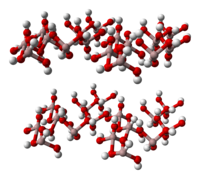Aluminum hydroxide
 |
|
 |
|
| Names | |
|---|---|
|
Preferred IUPAC name
Aluminium hydroxide
|
|
|
Systematic IUPAC name
Aluminium(3+) trioxidanide
|
|
| Other names
Aluminic acid
Aluminic hydroxide |
|
| Identifiers | |
|
21645-51-2 |
|
| 3D model (Jmol) | Interactive image |
| ChEBI |
CHEBI:33130 |
| ChEMBL |
ChEMBL1200706 |
| ChemSpider |
8351587 |
| ECHA InfoCard | 100.040.433 |
| PubChem | 10176082 |
| RTECS number | BD0940000 |
| UNII |
5QB0T2IUN0 |
|
|
| Properties | |
| Al(OH)3 | |
| Molar mass | 78.00 g/mol |
| Appearance | White amorphous powder |
| Density | 2.42 g/cm3, solid |
| Melting point | 300 °C (572 °F; 573 K) |
| 0.0001 g/100 mL (20 °C) | |
|
Solubility product (Ksp)
|
3×10−34 |
| Solubility | soluble in acids, alkalis, HCl, H2SO4 |
| Acidity (pKa) | >7 |
| Thermochemistry | |
|
Std enthalpy of
formation (ΔfH |
−1277 kJ·mol−1 |
| Pharmacology | |
| A02AB01 (WHO) | |
| Hazards | |
| Safety data sheet | External MSDS |
|
EU classification (DSD)
|
Irritant (I) Xi |
| R-phrases | R36 R37 R38 |
| S-phrases | S26 S36 |
| NFPA 704 | |
| Flash point | Non-flammable |
| Related compounds | |
|
Other anions
|
None |
|
Related compounds
|
Sodium oxide, aluminium oxide hydroxide |
|
Except where otherwise noted, data are given for materials in their standard state (at 25 °C [77 °F], 100 kPa).
|
|
|
|
|
| Infobox references | |
Aluminic hydroxide
Aluminium(III) hydroxide
Aluminium hydroxide
Hydrated alumina
Aluminium hydroxide, Al(OH)3, is found in nature as the mineral gibbsite (also known as hydrargillite) and its three much rarer polymorphs: bayerite, doyleite and nordstrandite. Aluminium hydroxide is amphoteric in nature, i.e, it has both basic and acidic nature. Closely related are aluminium oxide hydroxide, AlO(OH), and aluminium oxide (or alumina), Al2O3. Aluminium oxide is also amphoteric in nature. These compounds together are the major components of the aluminium ore bauxite.
The naming for the different forms of aluminium hydroxide is ambiguous and there is no universal standard. All four polymorphs have a chemical composition of aluminium trihydroxide (an aluminium atom attached to three hydroxide groups).
Gibbsite is also known as hydrargillite, named after the Greek words for water (hydra) and clay (argylles). The first compound named hydrargillite was thought to be aluminium hydroxide, but was later found to be aluminium phosphate; despite this, both gibbsite and hydrargillite are used to refer to the same polymorphism of aluminium hydroxide, with gibbsite used most commonly in the United States and hydrargillite used more often in Europe. In 1930 it was referred to as α-alumina trihydrate to contrast it with bayerite which was called β-alumina trihydrate (the alpha and beta designations were used to differentiate the more- and less-common forms respectively). In 1957 a symposium on alumina nomenclature attempted to develop a universal standard, resulting in gibbsite being designated γ-Al(OH)3 and bayerite becoming α-Al(OH)3 and nordstrandite being designated Al(OH)3. Based on their crystallographic properties, a suggested nomenclature and designation is for gibbsite to be α-Al(OH)3, bayerite to be designated β-Al(OH)3 and both nordstrandite and doyleite are designated Al(OH)3. Under this designation, the α and β prefixes refer to hexagonal, close-packed structures and altered or dehydrated polymorphisms respectively, with no differentiation between nordstrandite and doyleite.
...
Wikipedia

